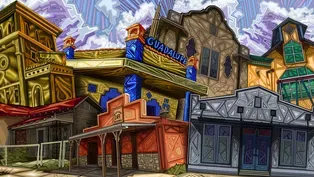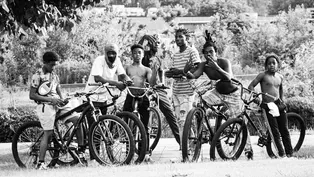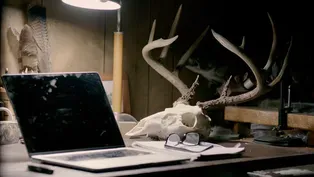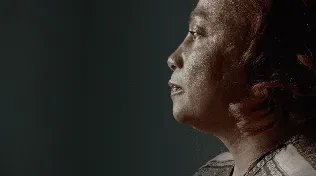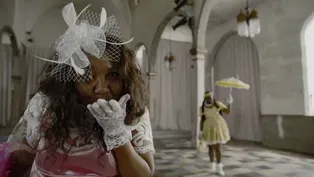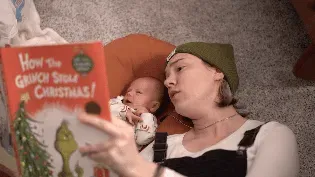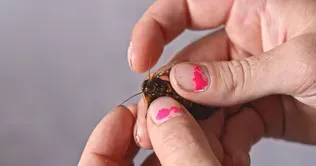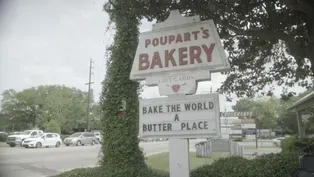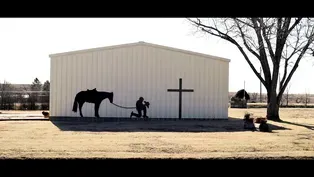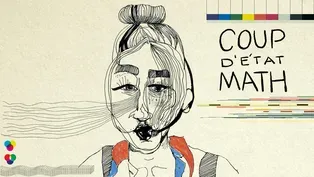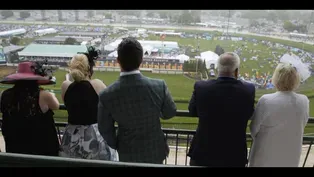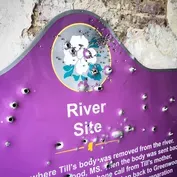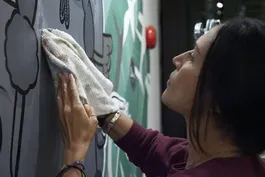
MISS CHELOVE: From Java to the Streets of D.C.
Special | 15m 33sVideo has Closed Captions
Artist MISS CHELOVE shares stories from her life growing up in the D.C. punk scene.
Indonesian-American artist Cita Sadeli, a.k.a. MISS CHELOVE, begins work on a mural in a soon-to-open Indonesian coffeehouse in Washington, D.C. As she paints, Cita talks about her life in the DMV area, her cultural heritage, the influence of punk and hip-hop on her life, and how she came to fall in love with graffiti in the 1980’s when there were few women drawn to the art at the time.
Problems with Closed Captions? Closed Captioning Feedback
Problems with Closed Captions? Closed Captioning Feedback
Support for Reel South is made possible by the National Endowment for the Arts, the Center for Asian American Media and by SouthArts.

MISS CHELOVE: From Java to the Streets of D.C.
Special | 15m 33sVideo has Closed Captions
Indonesian-American artist Cita Sadeli, a.k.a. MISS CHELOVE, begins work on a mural in a soon-to-open Indonesian coffeehouse in Washington, D.C. As she paints, Cita talks about her life in the DMV area, her cultural heritage, the influence of punk and hip-hop on her life, and how she came to fall in love with graffiti in the 1980’s when there were few women drawn to the art at the time.
Problems with Closed Captions? Closed Captioning Feedback
How to Watch REEL SOUTH
REEL SOUTH is available to stream on pbs.org and the free PBS App, available on iPhone, Apple TV, Android TV, Android smartphones, Amazon Fire TV, Amazon Fire Tablet, Roku, Samsung Smart TV, and Vizio.
Providing Support for PBS.org
Learn Moreabout PBS online sponsorshipMore from This Collection
Video has Closed Captions
RUBIO uses art to share folklore, remember friends, and celebrate the Westside community. (7m 26s)
Video has Closed Captions
A bowhunter in the Arkansas Ozarks meditates on the Cycle of Life after an animal harvest. (5m 45s)
Video has Closed Captions
Pamela Winn fights to end the shackling of incarcerated pregnant people in Georgia. (16m 55s)
Video has Closed Captions
The Mardi Gras Baby Dolls explore themes of identity and sexual liberation in New Orleans. (16m 21s)
Video has Closed Captions
A filmmaker records her wife’s introduction to motherhood, finding purpose in the process. (9m 51s)
Video has Closed Captions
Four women bond over crickets, worms, and roaches on an insect farm in Labelle, Florida. (14m 16s)
Video has Closed Captions
Francois starts a bakery in Lafayette, LA with a deep connection to his french culture. (8m 8s)
Video has Closed Captions
Darrouzett, Texas is a 100-year-old homestead community full of hope and nostalgia. (12m 27s)
Video has Closed Captions
Four immigrant stories: a fight to be born, to survive, find your place, and to maintain. (8m 45s)
Video has Closed Captions
A portrait of workers and revelers at the fastest 2 minutes in sports, the Kentucky Derby. (14m 43s)
Video has Closed Captions
A short film exploring the vandalism of signs in Mississippi marking Emmett Till’s death. (3m 43s)
Providing Support for PBS.org
Learn Moreabout PBS online sponsorship[ambient music] [street sounds] - Each mural site has its own characteristics.
When I first visit a site, you get to assess everything, the lighting, the space, the quality of the wall.
There's this communication that happens between yourself and the space.
You feel a lot of anxiety at times because there's this little voice inside of you that questions whether you can do it.
Even after all of these years, you turn into a beginner.
Well, for this piece at Dua, I felt a lot of pressure actually because in Washington DC, we haven't had a lot of major Indonesian-owned businesses for a really long time and I derive a lot of inspiration from my Javanese heritage.
How do we express that culture and American culture in a very authentic way?
[upbeat music] My name is Cita Sadeli and my graffiti name from many years ago is Chelove.
♪ Shimmy shimmy ya, shimmy yay shimmy yay ♪ ♪ Give me the mic so I can take it away ♪ ♪ Shimmy shimmy ya, shimmy yay shimmy yay ♪ To me, the artwork belongs in the streets because it's energetic and it's just as involved in the conversation that everyone's having with fashion, culture, music, identity, politics.
These messages belong in the street.
♪ Give me the mic, so I can take it away ♪ ♪ Shimmy shimmy ya ♪ It's important to balance that out with some questions about humanity, about yourself, about where you're going, about how you're feeling.
And I think public art really helps to echo these questions and experiences and just provides a great place to play.
I was raised in the suburbs of Washington DC in Hyattsville, Maryland, and spent most of my younger years in DC hanging out.
I'm half Indonesian and half Western European with a few splashes of Polynesia, India and some Krip Indian.
[light music] [light music] We were raised with our mom and she's Javanese from Indonesia, specifically from Java and it's a very spiritual mystical place.
She had this thirst for knowledge and for travel.
She was very excited about the world and she wanted to find a way to study abroad.
So in 1964, she came to Hawaii for an orientation for the Fulbright Scholarship that she received.
She was actually incredibly creative, incredibly spirited, great with rhythm and music.
She played for the Gamelan Troupe with the Indonesian Embassy.
She was a poet, a writer, just an all around renaissance woman, but she also was working constantly to support the family as a single mom.
[light music] [light music] I was the youngest of four kids, so you grow up a lot quicker.
[upbeat music] I started becoming really curious about the punks that we would see in Georgetown and the Stork, Commander Salamander and Smash and other stores.
[upbeat music] They would sell vinyl, there would be music, there would be flyers for shows.
And just getting into that culture and understanding that there's this whole universe.
♪ We're not the first ♪ ♪ Oh, but not the last ♪ ♪ 'Cause I know we're all headed ♪ ♪ For that yellow flesh ♪ ♪ And doubt it's unknown ♪ Growing up as this ethnically ambiguous other person, I think folks like that find a lot of comfort and belonging in finding a tribe and finding a crew.
♪ Which I promise ♪ [singer laughs] That was a gateway.
[upbeat music] And I started to get deeper into reggae music and then further into dancehall.
From there, morphed into underground electronic dance music in all of its forms.
I was deejaying at places like State of the Union down U Street with those clubs and Kaffa House.
And the culture of underground hip hop music in DC, very, very strong.
[upbeat music] So going through those threads and evolving with the city and evolving with these cultures and with the years, that still influences my artwork greatly.
[upbeat music] I remember the first time I saw a piece, a graffiti piece or a mural.
I was so excited because it was artwork that someone painted large scale on a building and the sheer size of it was extremely exciting to me.
I couldn't get it out of my mind.
I found other people that were doing graffiti in the area and started hanging out with them.
We would have these gatherings where everyone is sketching together in black books.
And then from there, we would go and paint.
[upbeat music] So it would be anywhere, anywhere you could find, you would paint.
One of those places was the Red Line on the DC subway system.
I think the reason why that line was so popular is because it has a lot of overground tracks and there aren't a lot of tunnels, also going through a lot of industrial areas where there were warehouses and places where there weren't a lot of people.
[upbeat music] And the Hall of Fame, which is another tunnel system by L'Enfant Plaza in DC.
If you wanted to learn about graffiti, you went there and you trained and you just kept at it until you got better.
There weren't a lot of other women doing graffiti at that time.
But honestly, growing up, it's been that situation a lot for me.
The excitement about this art form was so great that it made you fearless.
There was no thought about who's gonna see this afterwards.
It was very private.
I just wanted to use this spray can.
I wanted to use this tool.
That training that I had visually, I think it's still in my artwork in the energy of a line.
When you think about a tag, so much effort is placed on understanding these forms and the flow of these letters together.
So I think that's something that's really important for me in my work.
I can find those threads back to graffiti in every piece that I make.
You know what would look good?
That should be in the front, yeah.
[upbeat music] Well, for this piece at Dua Coffee, which means two in Bahasa, Indonesia, was actually opened by two colleagues of my mom, former colleagues of my mom's.
I'm gonna represent for Indonesia as much as I can.
Us being separated from our culture and from our land, my mom, she still was able to fold that into her life in big ways.
And it's really important for me to learn so much more about my culture.
That's the path I'm on now.
Maybe I should make these match the outline color, so it's more beautiful.
On December 11th in 2005, my mom was driving to the Voice of America where she had worked for over 20 years.
Just about five minutes away from the house, a drunk driver ran through a red light and t-boned her.
It's definitely a life-shattering moment.
Once you lose your last parent, it's like there's no umbrella.
There's nothing above me.
It's just me now.
So this nakedness that you feel... You feel so many different things.
My mother is no longer here for me to lean on for a reflection of my culture.
I can't ask her all the important questions about what things mean, what was her experience like.
So a lot of this is me reaching out and searching for those roots that were severed through that lost.
[light music] When she was still alive, she would tell stories of growing up in Java and having this really hard relationship with her mother.
And she would steal mangoes and climb up this kamboja tree, very popular tree in Indonesia.
She would run up there and she would be eating the mangoes and dropping the peels down and her mother would find her and, "Come down from there!"
But I would take scenes from these stories when we were growing up and make her a little paintings and things.
I was always connected to her stories, her experience and thinking about this place that we never saw.
I went in 1995 and the rest of my siblings went when we took her ashes.
There are things that you don't understand about your parent, why they do things and everything just makes sense when you go back home.
My family had rented this bus to go to our ancestral homeland.
And we were sitting in the back and I was just looking out at all my family.
I've never felt or seen that before.
They look like my mom, they look like me in ways.
It was just this incredible sense of belonging.
My mother's name was Sri Sadeli Kunz, but her nickname is Enny.
So this batik pattern that I put inside this piece is called the batik parang and it symbolizes the kris or sword, also called the tongue of fire.
The flowers in her headdress are the plumeria or kamboja, as they're called in Indonesia.
They were a flower that my mother really enjoyed.
And she spent a lot of time in Hawaii and those flowers are very plentiful there.
I think she really loved those because they reminded her of home.
Even where she's buried in the family plot in Kudus in Java, we've got those trees everywhere in the graveyard and the flowers are just falling all over the grave site.
So it's pretty meaningful for us.
She loved them so much, we got the flowers etched on to the plaque that goes onto the headstone along with the quote, "If you don't try, you'll never know."
That was something that was meaningful for us just in thinking about her coming from Java to America and just being so bold in her explorations in life.
My mother and her four children, she would always say, "Together, we make one fist."
We're very unified and strong that way.
And the petals for the flower, they're five.
So it's also meaningful in that way.
I always put her name in the piece.
So here I have her in the headdress, in the tassel.
[light music] I hope that when people see my artwork, they connect with the power of strong resilient women and I hope they connect with the power of the Indigenous.
Those are two really important aspects of my work that I really try to highlight and celebrate.
[upbeat light music] ♪ ♪ ♪ ♪ [crickets chirping]
MISS CHELOVE: From Java to the Streets of D.C.
Artist MISS CHELOVE shares stories from her life growing up in the D.C. punk scene. (48s)
Providing Support for PBS.org
Learn Moreabout PBS online sponsorshipSupport for PBS provided by:
Support for Reel South is made possible by the National Endowment for the Arts, the Center for Asian American Media and by SouthArts.
